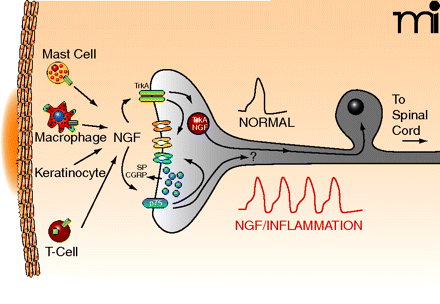
- Institution: Stanford Univ Med Ctr Lane Med Lib/Periodical Dept/Rm L109
- Sign In as Member / Individual
Unraveling the Story of NGF-mediated Sensitization of Nociceptive Sensory Neurons: ON or OFF the Trks?

Release of NGF produces sensitization of the peripheral terminals of sensory neurons. Upon localized tissue trauma, mast cells, macrophages, keratinocytes, and T cells all release NGF, which can then interact with its receptors, TrkA and p75, on the nerve endings. Bindings to the NTR activates intracellular signaling cascades that can modulate the activity of different ion channels in the nerve ending or could enhance the release of the neuropeptides, substance P (SP) and/or calcitonin gene-related peptide (CGRP). Under normal conditions, a noxious stimuli might elicit a single action potential whereas after treatment with NGF or as a consequence of inflammation, the nerve now give rise to multiple action potentials. Upon binding the neurotrophin, the TrkA-NGF complex may be retrogradely transported back to the cell body where it can modify the expression of multiple genes, e.g., ion channels. It is possible that p75 lacking NGF can be transported back to the cell body where it also serves to alter gene expression. See text for details.


